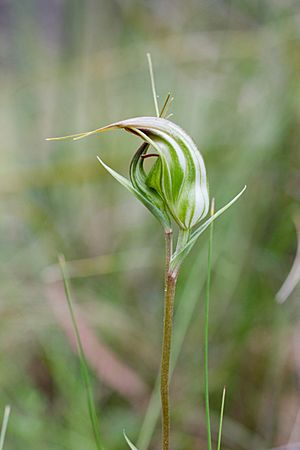Long-tongued summer greenhood facts for kids
Quick facts for kids Long-tongued summer greenhood |
|
|---|---|
 |
|
| Pterostylis aestiva growing in Namadgi National Park | |
| Scientific classification | |
| Genus: |
Pterostylis
|
| Species: |
aestiva
|
| Synonyms | |
|
Diplodium aestivum (D.L.Jones) D.L.Jones & M.A.Clem. |
|
The Long-tongued summer greenhood (Pterostylis aestiva) is a special type of orchid. It only grows naturally in south-eastern Australia. Like other "greenhood" orchids, this plant looks different depending on if it's flowering or not. Plants that aren't flowering have a flat circle of leaves on the ground. But when it's time to bloom, a single flower grows on a tall stem with leaves along it.
Contents
What the Long-tongued Summer Greenhood Looks Like
The Long-tongued summer greenhood is a plant that grows from an underground tuber (a bit like a potato). It's a perennial plant, meaning it lives for more than two years. It's also deciduous, so its leaves fall off at certain times.
When the plant is not flowering, it has a rosette of dark bluish-green leaves. These leaves are about 10 to 30 millimeters (0.4 to 1.2 inches) long. They are also about 10 to 15 millimeters (0.4 to 0.6 inches) wide.
The Flower's Appearance
Flowering plants grow a single flower on a stem that can be 150 to 350 millimeters (6 to 14 inches) tall. This stem also has three to five leaves on it. The flowers themselves are about 20 to 30 millimeters (0.8 to 1.2 inches) long and 7 to 9 millimeters (0.3 to 0.4 inches) wide. They are a mix of dark bluish-green, white, and brown colors.
The top part of the flower, called the dorsal sepal, joins with the petals. Together, they form a hood-like shape over the flower's central part, which is called the column. This hood is also known as a "galea." The dorsal sepal curves forward and has a thin, thread-like tip that is 8 to 12 millimeters (0.3 to 0.5 inches) long.
The two lateral sepals are held close to the galea. They also have long, thread-like tips that stand upright, measuring 25 to 35 millimeters (1.0 to 1.4 inches) long. There's a small gap or "sinus" between the bases of these sepals. The labellum, which is the orchid's special lip, is brown and curved. It's about 15 to 19 millimeters (0.6 to 0.7 inches) long and 4 millimeters (0.2 inches) wide. This part sticks out above the sinus. You can see these flowers blooming from January to April.
How This Orchid Got Its Name
The Pterostylis aestiva was first officially described in 1972. A botanist named David Jones found a sample of this orchid near a place called Wulgulmerang. He then wrote about it in a science journal called Muelleria.
The second part of its scientific name, aestiva, comes from a Latin word. It means "pertaining to summer," which makes sense because this orchid flowers during the summer months.
Where the Long-tongued Summer Greenhood Lives
The Long-tongued summer greenhood grows in certain parts of south-eastern Australia. You can find it among grasses in forests that get a lot of rain. It grows in north-east Victoria and in New South Wales. In New South Wales, it can be found as far north as Mount Canobolas.
Growing This Greenhood at Home
If you're interested in gardening, this greenhood orchid is fairly easy to grow in pots. When the plant is actively growing, it's important to keep the soil moist. However, when the plant is dormant (resting), the soil should be kept dry.

